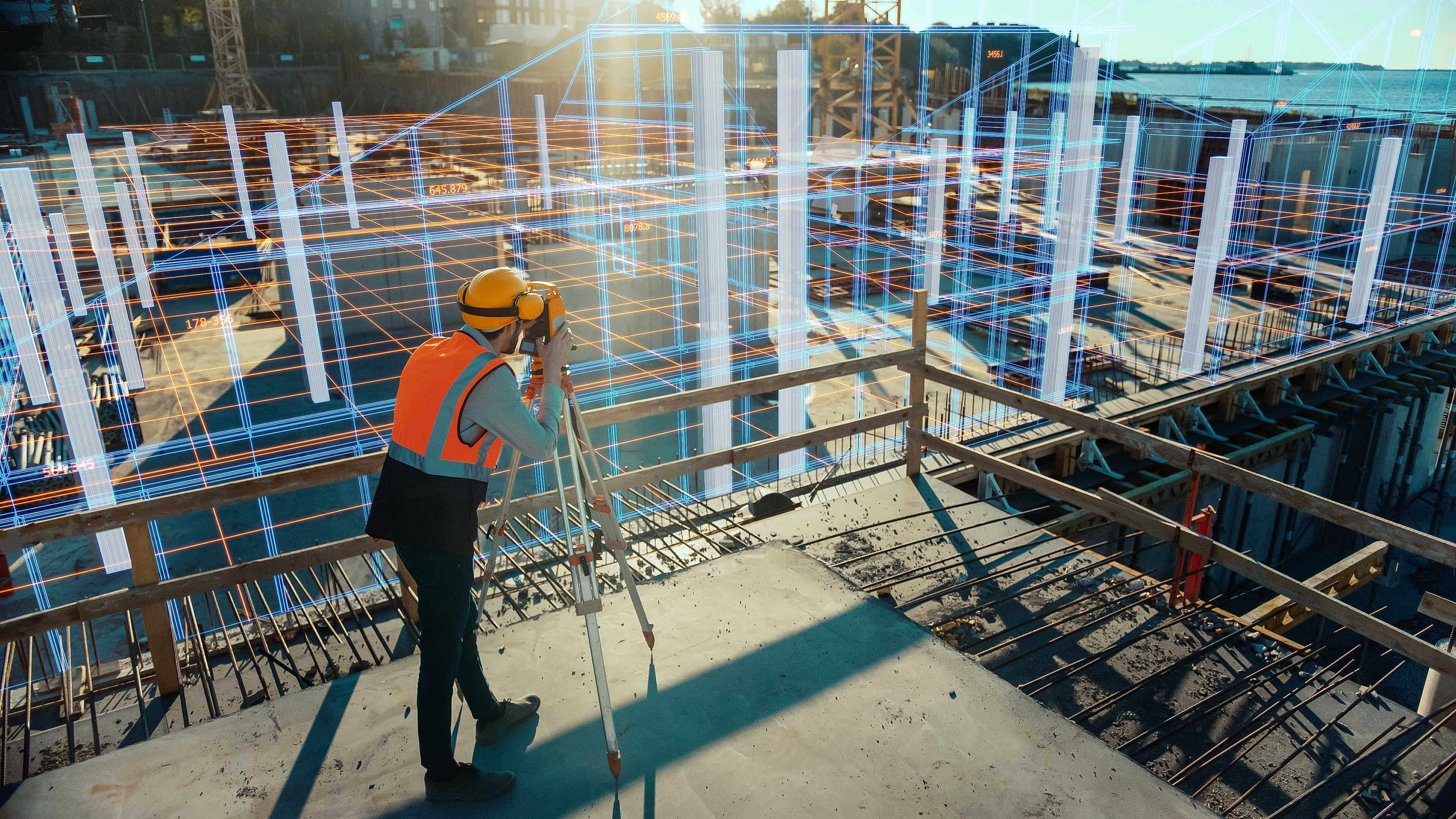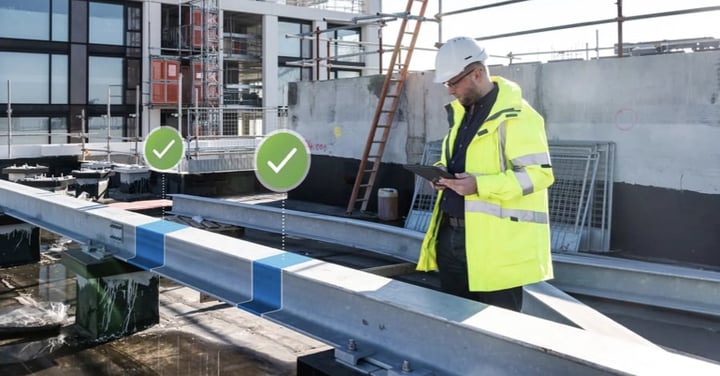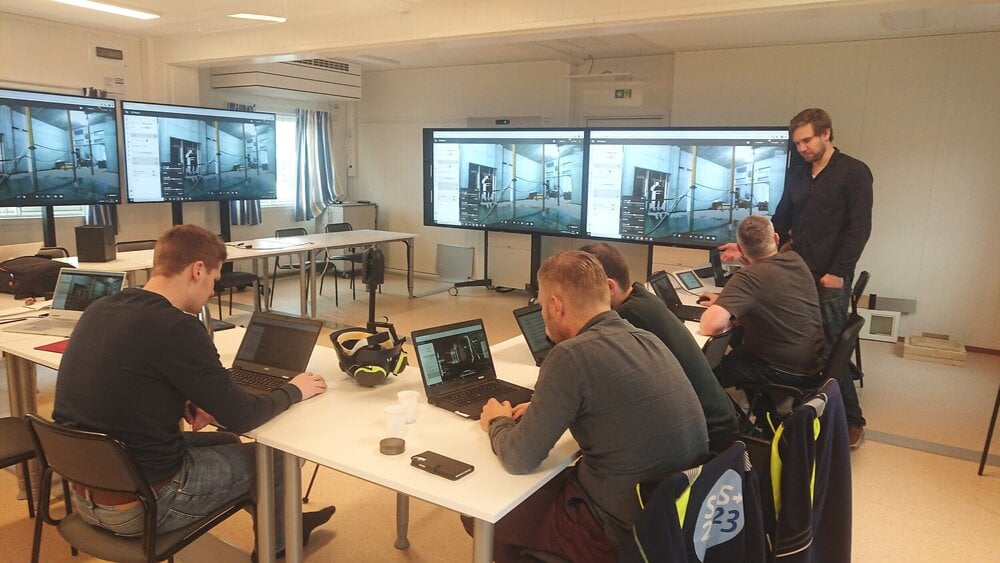Table of Contents
1. Sustainable Construction Tactics
2. Digital Construction and Tech Adoption Tactics
3. Tactics for Finding and Retaining Skilled Labour
4. Tactics for Better Quality Control in Construction
5. Tactics for Regulatory Compliance and Accountability
6. Tactics for Client Satisfaction and Relationship Building in Construction
1. Sustainable Construction Tactics
The construction industry has a critical role to play in addressing climate change and sustainability concerns. In Europe, the building sector is responsible for approximately 40% of total energy consumption and 36% of CO2 emissions. To secure the future of construction, the industry must adopt sustainable construction methods, minimise construction waste, and adopt environmentally responsible practices.
The following tactics help to achieve these goals.
Prioritise effective waste management.
Develop and implement a comprehensive waste management plan to minimise waste generation and ensure proper disposal of construction waste. Execute programs that promote re-use and recycling on construction sites and the adoption of circular practices across projects or companies.
Conduct research on sustainable construction materials.
Select materials with a lower environmental impact, such as those made from recycled content. This tactic helps minimise waste and contribute to sustainability efforts.
Use modular and prefabricated construction systems.
Adopting modular and prefabricated building systems helps reduce the amount of waste from onsite fabrications, while minimising construction time and costs.
Tip 💡: To better execute on this tactic and identify deviations that may impact the junctions or interfaces of prefabricated elements, establish a regular routine for tracking the As Built status of your jobsite. Such a proactive approach will help to stay on top of any potential issues. Learn how Byggstyrning succeeds with prefabricated construction by using Imerso>>.
Collaborate closely with suppliers and subcontractors.
Work closely with suppliers and subcontractors to minimise waste and promote sustainability practices. This collaboration can greatly reduce the environmental impact of construction projects.
It’s crucial to set ambitious environmental goals at the project level and establish clear incentive schemes to encourage all parties working towards the same objective.
Tip 💡: Provide your team with a shared platform where all stakeholders have access to accurate information about the project's current status and any changes from the original plans. This way, everyone stays informed and can adjust their plans and work accordingly. Usage of such shared platforms, like Imerso lead to better execution, less waste, and improved sustainability practices.
Integrate modern construction software.
The use of construction software and digital tools, such as project management software, digital twins, 3D scanning and AI, can greatly improve sustainability efforts in construction. The combination of these new tools provides a faster and more agile sharing of accurate project information across all parties. This in turn enables a more streamlined building process with less resource and material waste.
Embrace lean construction principles.
Lean construction practices contribute to reducing errors, delay costs, and help enhance sustainability in construction. Implement rapid iteration cycles into your execution plans and project management practices: build, check, improve and repeat at every stage. The closer these loops follow the construction work, the higher degree of control and opportunity for waste mitigation. Learn how Per Aarsleff cuts rework and delay costs ten times by implementing lean principles with Imerso.>>
2. Digital Construction and Tech Adoption Tactics

Digital transformation is rapidly taking over the construction sector, and tech adoption is the key to success.
Automation in construction is a much bigger topic than simply going paperless. There are a lot of efficiency gains your company can benefit from moving its paper-based processes into a modern collaboration app. But digital transformation can’t stop there.
Think of all the manual processes your teams currently perform by hand, or visually with photos, or requiring in-person visits to the site. Consider anything that could be automated by software or machines, so your teams could focus their work time on what they do best.
This is what digital construction is all about – give your teams the tools they need, so they could do more with less, and make faster and better decisions based on data and facts instead of opinions. Through better flows of information, you will see drastic results in improved project management capacity and easier team collaboration. Your teams will have an easier time staying on the same page, and knowing what’s expected of them. The following tactics will help you achieve such results.
Invest in digital construction tools.
Create internal champions or even departments devoted to Virtual Design and Construction (VDC) and Building Information Modelling (BIM) methodologies. Create in-house forums, such as events or newsletters, where these champions can disseminate learnings and results from pilot tests of new tools.
Invest into new-generation software and process automation tools to streamline project management and improve efficiency. Get started with our overview of the most popular construction software tools here.
Most of all, don’t let your teams get stuck in testing all tools in the market to make the best choice in the end. This is the wrong approach, since innovation is accelerating fast. By the time tests are done, and a decision is made, other tools might have jumped ahead without your knowing. Keep your market studies short, and rather prioritise real-life implementations over tool-selection, as the only way to really learn which features really matter and have a strong impact in reality.
Foster a digital construction culture.
Create a culture where innovators are incentivised to take risks and rewarded for their initiatives. You might create a dedicated innovation budget and encourage out-of-the-box thinking. Encourage your team to embrace new technologies and accelerate digital transformation. Provide training and support for employees to learn new ways of working and maximize their potential. Consider creating internal incentives to measure and document productivity improvements from new tools.
More digital construction and tech adoption tactics, you’ll find in our Free 2024 Tech Guide>>.
3. Tactics for Finding and Retaining Skilled Labour

To maintain growth and success, construction companies must address the growing risk of a shortage of skilled labour. Currently, 75% of contractors face difficulties in recruiting skilled workers, while 96% of firms suffer from skilled labour shortages. To attract and retain talented workers, companies must take proactive measures. Below are some tactics that help companies attract and retain talent.
Promote your company’s digital construction journey.
This tactic requires showcasing your company's advanced technology and modern work methods, such as project management software, digital collaboration tools, and innovative automation systems. Highlight the efficiency and benefits of these tools to attract and retain talent.
Invest in talent training and development.
Develop training and development programs to help new employees acquire necessary skills quickly and efficiently, and incentivize ongoing learning for current employees. Implement systems that track employee performance and reward outstanding results.
Adopt competitive performance compensation packages.
Launch a pay-for-performance model that rewards employees for their achievements and motivates them to work harder towards the company's goals. Set clear metrics to track employee performance and align their compensation with their results.
Provide career progression opportunities.
Offer training programs, certifications, and leadership opportunities to help employees develop their skills and progress in their careers. Provide opportunities for mentorship and collaboration between experienced and new employees.
Improve working conditions of construction builders.
Invest in technology that maximises remote worker efficiency. For example, Imerso enables teams to cut their travel costs in half with virtual site visits from any browser or device.
Implement safety protocols to ensure worker safety and comfort. Finally, provide onsite childcare and flexible working arrangements to support employees with families.
Support women in construction.
Develop programs specifically aimed at attracting and retaining women. These programs can include mentorship and networking opportunities, creating a supportive workplace culture, offering flexible working arrangements to accommodate childcare needs, and providing equal opportunities for training and career advancement. Showcase success stories of women who have thrived in the industry to inspire more women to join and stay in the field.
Enable direct information sharing.
Encourage direct communication between executives and junior employees to promote transparency and knowledge-sharing. Emphasise the importance of allowing new and younger employees to showcase their work and ideas, and provide opportunities for them to present to management.
Collaborate with construction education institutions.
Collaborate with local education institutions to create apprenticeship and training programs, and showcase your company's working environment to attract new talent. Help to develop the skills of the next generation of workers and create a pipeline of skilled workers for the company.
4. Tactics for Better Quality Control in Construction

Better control on construction sites leads to gained competitive advantage and improved project outcomes. McKinsey found that digital technologies and advanced project management techniques can improve project outcomes by up to 45%. Effective project management processes and technologies, such as project management software and routine site inspections using software like Imerso, helps identify and address potential issues quickly. Regular communication with stakeholders and clients can also reduce misunderstandings and conflicts.
Let's review some of the best tactics to use below.
Develop a detailed execution plan.
Come up with a project plan that outlines all aspects of the construction project, including timelines, budgets, and milestones. Learn more about VDC, BIM, and model coordination to effectively troubleshoot the project virtually ahead of the construction execution phase.
Align on project roles and responsibilities.
Assign clear roles and responsibilities to all team members, ensuring everyone knows what’s expected of them, the tools they should be using, and what they’re responsible for.
Foster a culture of collaboration between all stakeholders, including clients, contractors, and project teams, to ensure everyone is working together to achieve project goals. Promote shared incentives in your contract schemes to eliminate the “not my responsibility” factor.
Set proactive quality control in construction.
Implement proactive quality control measures, including regular site inspections with accurate, indisputable site data to identify and address potential issues in real-time. Leverage Imerso to automate regular jobsite inspection processes and achieve results of expert surveyors within hours, at a fraction of the cost.
Introduce construction project management software.
Utilise project management software like Dalux, BIMsync, BIM Collab, Autodesk Construction Cloud, or StreamBIM to centralise project documentation and keep everyone informed in real-time.
Track progress and performance closely.
Follow the Lean principles and implement frequent inspection routines. Aim to have a check and measure point at every planned milestone. The more granular these inspection loops are, the higher the opportunity to spot errors early and get them fixed before the next team moves in.
Automate field monitoring workflows with tools like Imerso, which make 3D scanning simple, so your teams can accurately track what’s happening onsite in real-time, identify potential issues early and address them proactively. Leave post-it notes and red-line drawings behind, and never look back. Learn how Per Aarsleff cuts rework and delay costs ten times by implementing lean principles with Imerso>>.
Update the construction project plan.
Regularly review and update the project plan to ensure relevancy, accuracy to reality. This will help to identify and address any potential issues. You can use Imerso’s automatic BIM-updating feature to keep your models accurate to the current As Built status at the site.
5. Tactics for Regulatory Compliance and Accountability

Construction companies are responsible for ensuring that all work carried out at their jobsites is compliant with relevant regulations and standards.
To control regulatory compliance, create processes to identify and assess relevant regulations, and ensure that all work is compliant. This can involve regular site inspections, regular review of relevant documentation, and regular engagement with relevant regulatory authorities. We recommend following the tactics described below:
Organise regular training.
Ensure all staff are regularly trained on relevant regulations, standards, and best practices.
Take care of documentation management.
Implement a robust documentation management system to ensure all relevant documentation is available, up-to-date, and accessible to relevant staff.
Monitor compliance proactively.
Monitor compliance with regulations and standards through site inspections, documentation reviews, and engagement with regulatory authorities. Automate compliance in design models using Solibri's custom rulesets. Use Imerso to track As Built status and identify any deviations from planned models. Import As Built data from Imerso into Solibri to investigate consequences of work deviations, accelerate decision-making for issue resolution and ensure regulatory compliance.
Set a goal for continuous improvement.
Implement processes for continuous tracking of the field status and verifying regulatory compliance at every step of the project. Develop and implement a system for managing non-compliance, including processes for reporting and addressing non-compliance incidents and for tracking the resolution of non-compliance issues.
File format compatibility is one way to enable data exchange between software systems. For example, if two software systems can read and write to a commonly-used file format, such as CSV or XML, then data can be easily exported from one system and imported into another.
Direct API integrations provide a more seamless way to share data between software systems. APIs enable software systems to communicate with one another directly, allowing data to be transferred automatically and in real-time. This approach can help to reduce errors, improve data accuracy, and streamline project workflows.
6. Tactics for Client Satisfaction and Relationship Building in Construction

Construction companies rely on client satisfaction and strong relationships to secure repeat business and maintain a positive reputation in the industry. This requires a commitment to delivering high-quality work, being responsive to client needs, and being transparent and honest in all communications and interactions. Let’s review tactics to achieve these goals.
Focus on proactive communication.
Implement processes for regular and proactive communication with clients to keep them informed of project progress, address any concerns and respond promptly to any questions or requests. Demonstrate that your teams are in control, and showcase the methods your company uses to ensure this – what makes it unique about your teams that your client can confidently continue choosing your business.
Gather feedback about your construction projects.
Regularly gather feedback from clients on the quality of work, customer experience, and overall satisfaction, and act on this feedback to continuously improve performance. Implement measures to proactively increase engagement and involvement of your customer’s teams into the building process.
Manage construction quality.
Invest in quality management processes to ensure that work is delivered to the highest standard, and that any issues are addressed early, promptly and effectively. Leverage industry-leading tools Imerso, Solibri, and Dalux to stay ahead of the curve in site monitoring, model coordination, and documentation sharing.
Conclusion
This 2024 Construction Playbook provides valuable insights into the top six challenges facing the construction industry and offers practical solutions to overcome them. As the industry continues to evolve and adapt to new technologies and changing market conditions, it’s critical to stay informed and implement effective tactics to remain competitive. Ultimately, the success of the construction sector depends on the ability of companies to navigate these challenges and leverage new opportunities to drive growth and innovation.
About Imerso
Imerso is a software platform that combines BIM, Reality Capture, and AI technologies to automate construction site supervision and quality inspections with one simple workflow. We help construction companies cut project risks and delay costs with real-time monitoring of site status and work quality. Learn more here>>.

.png?width=350&height=147&name=Imerso_Logo_A4_White_Transp%201%20(1).png)

